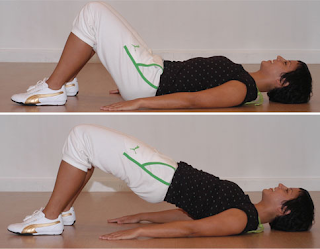Since time in memorial, menstrual cramps have always been such a big problem for girls everywhere. Being someone who has gone through extreme lengths (please refer to the previous post) just to relieve the pain, it was ultimately exercise and proper diet that finally allowed me to get rid of the monthly pain monster.
Menstrual cramps may actually be relieved by simple exercises that you can do at home (although it’s better to do it with the assistance of a professional fitness instructor to ensure proper posture and execution). Focus on relaxing (yoga, walking or jogging) and core-strengthening (lunges, crunches and squats) exercises; target the lower abdominal muscles nearer to the uterus.
• LUNGES
Starting position. Stand up straight with hands on waist. Position feet with a little less than shoulder width apart.
With dumbbells. Choose dumbbells of a weight that will enable you to complete the exercise sets you have chosen.Stand up straight with a dumbbell on each hand. Let your arms hang on each side,palms facing your thighs (hammer grip).
INHALE: Take a big step forward (with either leg) while bending at the knee until the front thigh is approaching parallel to the ground, and the rear leg is bent at the knee and balanced at the toes. NOTE: Don’t let the knee (front leg) go past the tip of the toes. This can aggravate the knee joint if done too much.
EXHALE: Tighten your abs and PUSH back up to your starting position. It’s important to keep weight evenly distributed between both legs.
Complete reps before doing it with the other leg (set # 1). Execute 10-12 reps for 1-3 sets.
• SQUATS
 Starting position. Stand with your feet a few inches wider than your shoulders and toes pointing outward at a 45-degree angle. Arch your back and stick out your chest.
Starting position. Stand with your feet a few inches wider than your shoulders and toes pointing outward at a 45-degree angle. Arch your back and stick out your chest.INHALE: Bend your knees. Tighten your abs as you go lower into a squat, taking your hips back, until your knees are at 90-degree angles. NOTE: Focus your weight on your heels. You can do this by slightly lifting your toes. Also, same with lunges, make sure your knees don’t go beyond your toes.
EXHALE: Stand back up to starting position. Complete 1-3 sets of 10-16 reps.
For safe execution, remember to always place your weight on your heels which should be kept flat on the floor. Also, you must maintain a natural arch on your lower back as you keep your shoulders back and your head and neck in a neutral position throughout the exercise.
• REVERSE CRUNCHES

Starting position. Lie on the floor (mat) and place hands (palm down) on the floor or behind the head. Bring your knees in towards your chest (90 degrees) with feet together or crossed, hips flat on the floor.
With a ball. Sit on a mat and place a stability ball between your legs (at your calves/ankles). Squeezing the ball in place, lie back onto the floor, keeping feet just off the ground, knees bent.
EXHALE: Contract (squeeze) the abs to curl the hips off the floor, reaching the legs towards the ceiling (or at least as far as you can go).
INHALE: Slowly lower to starting position without letting your feet rest in between sets.
Do 12-16 reps for 2-3 sets. It’s a very small movement, so try to use your abs to lift your hips. Avoid swinging your legs and creating momentum.
• BRIDGE (Pelvic Stretch)
 Starting position. Lie down placing your back and feet flat on the floor with your knees bent (make sure your feet are under your knees), and arms on your sides (palm down).
Starting position. Lie down placing your back and feet flat on the floor with your knees bent (make sure your feet are under your knees), and arms on your sides (palm down).EXHALE: Slowly lift your hips up creating a straight (diagonal) line from your knees to your shoulders. Remember to contract your glutes and abs.
INHALE: Gently lower yourself back to starting position.
Execute 15 reps for 2-3 sets.
• PELVIC TILT EXERCISES
 Starting position. Stand up with your feet hip distance apart and your knees slightly bent. Place your hands on your hips near the hip bone.
Starting position. Stand up with your feet hip distance apart and your knees slightly bent. Place your hands on your hips near the hip bone.INHALE: Rock your pelvis forward. Hold for about 3 seconds.
EXHALE: Move your pelvis back to starting position.
 Perform 2-3 sets of 12-15 reps.
Perform 2-3 sets of 12-15 reps.It can also be done seated on a chair or lying down on a mat.
Remember: AIR & WATER!
Oxygen and water are needed by your muscles to work on your exercises. Also, hydrated and well-oxygenated muscle tissue is less likely to cramp. So, don’t forget to breathe deeply and drink enough water.
Aside from these two, it is equally important to do some stretching before and after working out to prevent injury.



No comments:
Post a Comment